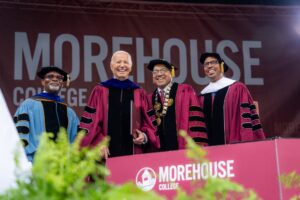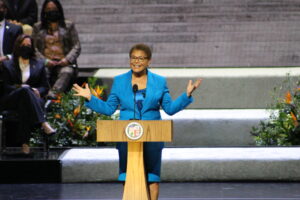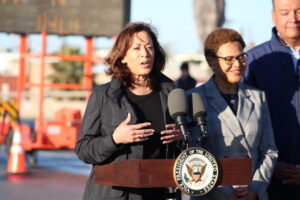As her first act in office, Mayor Karen Bass declared a state of emergency on homelessness and activated the city’s Emergency Operations Center (EOC). The declaration recognizes the severity of Los Angeles’ crisis and breaks new ground to maximize the city’s ability to urgently move people inside.
“My mandate is to move Los Angeles in a new direction, with an urgent and strategic approach to solving our city’s toughest challenges and creating a brighter future for every Angeleno,” said Mayor Bass. “Today, on my first day in office, we hit the ground running, with a sea change in how the city tackles homelessness.”
The order immediately gives Mayor Bass the power to lift rules and regulations that slow or prevent the building of permanent and temporary housing for the unhoused; to expedite contracts that prioritize bringing unhoused Angelenos inside; and that allow the city to acquire rooms, properties and land for housing for Angelenos in need. Moving forward, Mayor Bass will issue executive directives to advance these critical reforms.

Immediately prior to signing the declaration, Mayor Bass met with her department heads – as well as the heads of the Los Angeles Homeless Services Authority and Metro – to outline her strategy to move Los Angeles forward with a unified approach to homelessness. The Los Angeles County CEO was also present for the meeting. She also met with frontline service providers and Janice Hahn, Chair of the Los Angeles County Board of Supervisors; Hydee Feldstein Soto, City Attorney; Kenneth Mejia, City Controller; Paul Krekorian, City Council President; Curren Price, President pro tempore, Los Angeles City Council; and Nithya Raman, Los Angeles City Councilmember and Chair of the Homelessness and Poverty Committee. All of the above attended the signing.
Declaration of Local Emergency
WHEREAS, Section 231(i) of the Los Angeles City Charter and Ch. 3, Section 8.27 of the Los Angeles Administrative Code provide that the Mayor of the City of Los Angeles has the authority to declare the existence of a local emergency as a result of any occurrence which, by reason of its magnitude, is or is likely to become beyond the control of the normal services, personnel, equipment, and facilities of the regularly constituted branches and departments of City government; and
WHEREAS, the City of Los Angeles has at any given time approximately 41,980 people experiencing homelessness Citywide; and
WHEREAS, the number of unhoused people in the City of Los Angeles has increased dramatically in recent years, nearly doubling in the past decade, with the number of unhoused families increasing by 238 percent since 2007; and
WHEREAS, the City of Los Angeles represents 9.6 percent of the State of California’s population but 25 percent of the State’s unsheltered population, and the City represents only 1.2 percent of the total United States population but 7.2 percent of the United States population of people experiencing homelessness; and
WHEREAS, as a percentage of its population, the number of unsheltered people in the City of Los Angeles is approximately 18 times higher than the number in New York City and 14 times higher than the number in Chicago; and
WHEREAS, there are more people currently experiencing homelessness in the City of Los Angeles than were displaced by Hurricane Harvey in Houston (30,000) or the 1994 Northridge Earthquake (20,000); and
WHEREAS, homelessness has disproportionately impacted Black, Indigenous and Immigrant Angelenos. Black people comprise only 8 percent of the population of the City of Los Angeles but, in the most recent homelessness count, accounted for 33 percent or more of people experiencing homelessness; and
WHEREAS, homelessness has increased dramatically and disproportionately among Hispanic and Latino Angelenos during the COVID-19 pandemic. The share of the population of people experiencing homelessness who are Hispanic or Latino increased by 30 percent between 2020 and 2022 and now constitute 42 percent of unhoused individuals. Black and Brown Angelenos comprise 75 percent of people experiencing homelessness; and
WHEREAS, the homelessness crisis has had unacceptable consequences for Angelenos, including a significant death toll that has rapidly increased since the start of the COVID-19 pandemic. The Los Angeles County Department of Public Health has reported an average of over 5 deaths per day of unhoused persons as of March 2021, a 200 percent increase in the death rate of persons experiencing homelessness over the past decade and a 56 percent increase over just one year prior; and
WHEREAS, women now comprise about a third of people experiencing homelessness and at least 60 percent of those women have experienced violence, and more than a third of LGBTQ+ women experiencing homelessness have experienced sexual assault; and
WHEREAS, a disproportionate share of youth experiencing homeless identify as LGBTQ+ and lack adequate access to resources; and
WHEREAS, the murder rate for people experiencing homeless is at the highest recorded levels, and increased by 47 percent in 2021 alone; and
WHEREAS, severe overcrowding in Los Angeles has also led to increased deaths from COVID-19. In neighborhoods with 40 percent overcrowding as compared to a national average of 3 percent, residents are 11 times more likely to die because of COVID-19; and
WHEREAS, shelter and housing is particularly important during these coming winter months when people experiencing homelessness in the City are likely to face heightened exposure and dangers from living outdoors, and heightened dangers from the combination of COVID-19, flu outbreak and respiratory syncytial virus (RSV). It is projected that the City will face an acute shortage of winter homeless shelters through March 2023, with fewer than half the number of shelter sites available as in the winter of 2021-2022 and nearly two-thirds fewer shelter beds; and
WHEREAS, the City’s eviction moratorium, which has protected many Angelenos from falling into homelessness, ends concurrently with the end of the City’s State of Local Emergency regarding the COVID-19 pandemic on February 1, 2023; and
WHEREAS, the State of California’s COVID-19 State of Emergency, which has provided resources to keep many Angelenos from falling into homelessness, ends in February of 2023, thus requiring immediate action in order to create replacement and additional housing and shelter, and in order to support the necessary infrastructure and laws required to protect and provide that shelter and housing; and
WHEREAS, people experiencing homelessness suffer disproportionately from mental and physical health ailments, the treatment of which has strained the City’s ability to provide appropriate shelter and housing and which require assistance from the County Health Department to provide the necessary public services. Specifically, it is estimated that 47 percent of unsheltered people in the City of Los Angeles are affected by a health condition, 46 percent are affected by substance abuse, 34 percent are affected by a serious mental illness, 29 percent are affected by physical disabilities, 17 percent are affected by post-traumatic stress disorder, 7 percent are affected by developmental disabilities, and 6 percent are affected by traumatic brain injuries. Recent studies differ on the exact percentages but dramatic increases over time are prevalent in all of the data. The prevalence of extreme need significantly stress the City’s public services; and
WHEREAS, notwithstanding that the State of California has enacted a CARE Court to address the crisis of untreated mental illness, the beds and necessary access to acute and subacute care is in development and steps must be taken in the interim to provide increased access to care; and
WHEREAS, the homelessness crisis has strained the City’s public safety resources. Among other things, occurrences of fires related to homelessness have nearly tripled between 2018 and 2021, averaging 24 fires a day in the first quarter of 2021, and now constitute a majority of all fires to which the Los Angeles Fire Department responds; and
WHEREAS, paramedic calls to address the crisis on our streets and in our other public spaces are increasing at alarming rates and unhoused residents are 19 times more likely to require an emergency room transport by paramedics than housed residents; and
WHEREAS, the homelessness crisis confronting Los Angeles has grown both incrementally and exponentially, leading to death, illness, and deplorable living conditions even worse than those that created emergencies due to persistent and worsening conditions from prison overcrowding, deterioration in water quality, or fire risk due to climate change; and
WHEREAS, the conditions in December 2022 are even more dire than when Mayor Bradley declared a local emergency due to the upcoming winter weather and its effects on the people experiencing homelessness in 1987; and
WHEREAS, the displacement of the number of people living on the streets of the City of Los Angeles today is a daily recurring emergency, empowering the Mayor to declare a state of emergency, no less than if the emergency was caused by an earthquake, fire, or flood; and
WHEREAS, the City’s ability to mobilize local resources, coordinate interagency response, accelerate procurement of housing units, use mutual aid, and seek assistance and potential reimbursement by the State and Federal governments will be critical to successfully responding to this homelessness crisis; and
WHEREAS, during the pendency of the existence of a local emergency, the Los Angeles City Council shall retain its full authority to consider a variety of City ordinances to codify the measures necessary to address this homelessness crisis; and
WHEREAS, during the COVID-19 pandemic the City Council created the COVID-19 Homelessness Roadmap and committed the funding and resources needed to produce 6700 housing options in 18 months; and
WHEREAS, the City currently has 14,475 interim housing beds and the City Council continues to prioritize the building of interim and permanent supporting housing and yet need outpaces demand; and
WHEREAS, the City projects it will soon have a total of 12,908 supportive and affordable units, of which 3,861 have been completed already, 5,171 are currently under construction, and 3,876 are in pre-development; and
WHEREAS, notwithstanding that Council has been and is acting with urgency, including implementing a roadmap to house thousands of Angelenos and building an unprecedented number of supportive housing units and shelters, an emergency declaration is necessary to mobilize resources, save lives, and provide for the public health, welfare, and safety of all; and
WHEREAS, the City of Los Angeles has responded to the rapid increase in its homeless population with unprecedented investments into homelessness solutions, including a nearly $1.2 billion commitment in the 2022-2023 City budget for the construction of thousands of units of supportive housing, the expansion of bridge housing, and the hiring of professionals to address the homelessness crisis and, notwithstanding these efforts, the number of those experiencing homelessness in the City continues to increase and outstrip the resources and services that the City has provided; and
WHEREAS, the magnitude of loss of life, the persistent and disproportionate impact of the COVID-19 pandemic, and the persistent discriminatory impacts of a lack of housing warrant and necessitate that I declare the existence of a local emergency; and
WHEREAS, the benefits of this emergency declaration, coupled with past and future actions by the Los Angeles City Council to address the homelessness crisis, will help ensure that this local emergency will be of a temporary nature;
NOW, THEREFORE, I thereby declare the existence of a local emergency and direct all Divisions of the Emergency Operations Organization (EOO) and all other City Departments to take necessary steps for the protection of life, health and safety in the City of Los Angeles.
I REQUEST, that the City Council adopt resolutions pursuant to the Los Angeles Administrative Code Sections 10.1.1, 10.2.1, 10.5(a)(8), and 10.5.5 to expedite the procurement and contracting process for materials, equipment, and services necessary to respond rapidly to the homelessness crisis.
I DIRECT that, as Director of the EOO, I shall coordinate Citywide planning and response with respect to unsheltered individuals in conjunction with the City Administrative Officer, Los Angeles Homeless Services Authority, Los Angeles City Housing Department, Los Angeles City Planning Department and any and all necessary departments and agencies.
I FURTHER DIRECT that the City coordinate its efforts to address this declared emergency with the County of Los Angeles, the State of California, and the federal government.
I FURTHER DIRECT, that the continuing state of emergency shall be regularly evaluated, in coordination with City Council, by reference to key performance indicators of progress in addressing the emergency, including, but not limited to:
● Decrease in the number and size of encampments;
● Regulatory relief from other jurisdictions and within Los Angeles City agencies to create flexibility to address the crisis;
● Relaxation in the restraints that limit the ability of the City’s proprietary departments to create flexibility to address the crisis;
● Increased housing placements;
● Increased starts on new affordable housing options;
● An increase in temporary and permanent housing units;
● Increased outside aid through access to mental health and substance use beds;
● A decrease in the number of persons being evicted from existing housing units;
● A decrease in the number of persons falling into homelessness.
I FURTHER DIRECT that this Emergency Declaration sunset in six months subject to being renewed. The setting of a specific time frame allows for actions to be taken to make permanent, necessary structural changes.
I FURTHER DIRECT that all relevant City departments and agencies compile and deliver to the Mayor information about the specific and necessary resources and support that the City should request from Los Angeles County, the State of California and the Federal government to address this crisis.
I THEREFORE DIRECT that the Declaration of Local Emergency shall take effect immediately and that notice shall be given of said Declaration through the most feasible means.


























